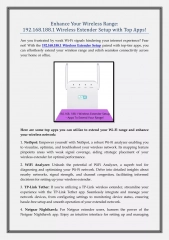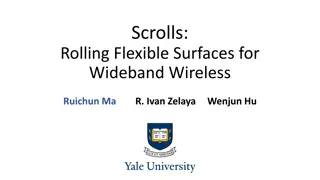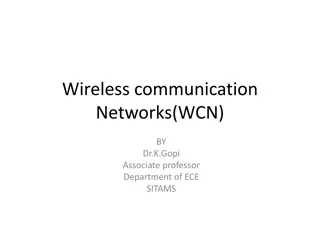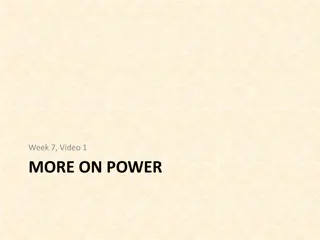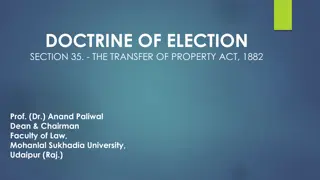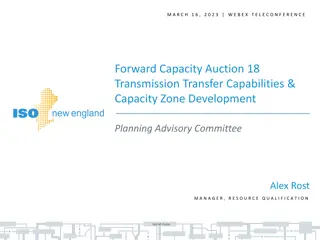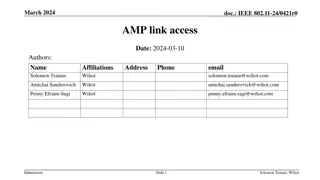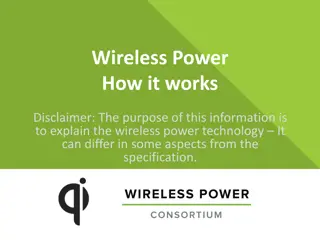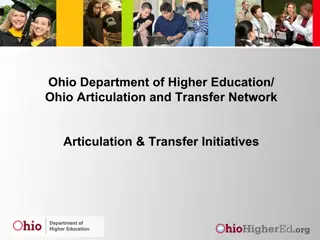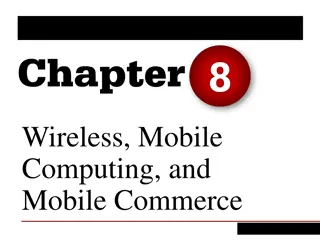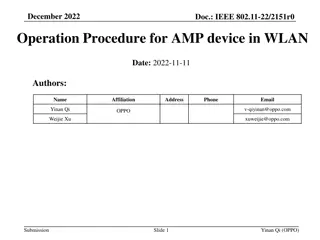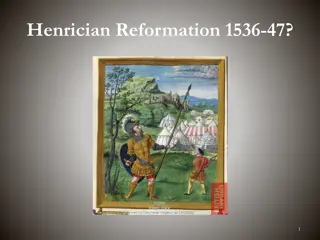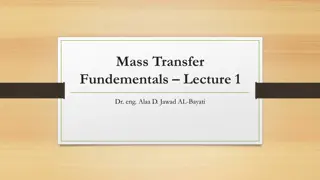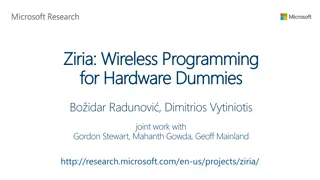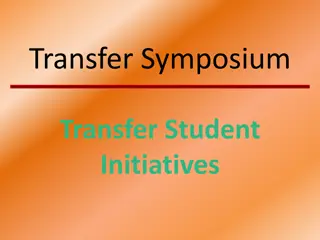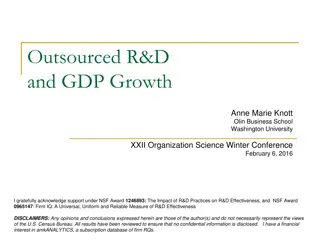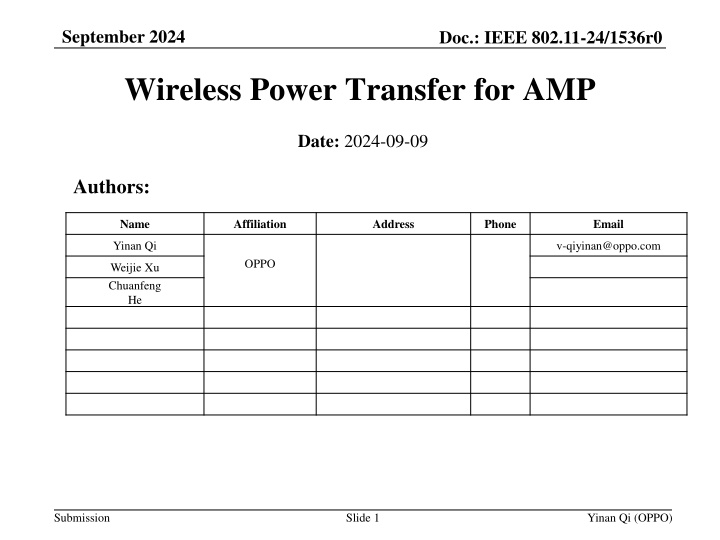
Wireless Power Transfer for AMP: Coexistence Challenges and Solutions
Explore the challenges and solutions related to Wireless Power Transfer (WPT) for AMP devices as discussed in IEEE 802.11-24/1536r0 documents from September 2023 and 2024. Topics include general views, coexistence requirements, energizer design, and main challenges in implementing WPT alongside communication systems. Learn about the importance of frequency considerations, energy harvesting sensitivities, interference coordination, and more in optimizing WPT efficiency for AMP technologies.
Download Presentation

Please find below an Image/Link to download the presentation.
The content on the website is provided AS IS for your information and personal use only. It may not be sold, licensed, or shared on other websites without obtaining consent from the author. If you encounter any issues during the download, it is possible that the publisher has removed the file from their server.
You are allowed to download the files provided on this website for personal or commercial use, subject to the condition that they are used lawfully. All files are the property of their respective owners.
The content on the website is provided AS IS for your information and personal use only. It may not be sold, licensed, or shared on other websites without obtaining consent from the author.
E N D
Presentation Transcript
September 2024 Doc.: IEEE 802.11-24/1536r0 Wireless Power Transfer for AMP Date: 2024-09-09 Authors: Name Affiliation Address Phone Email Yinan Qi v-qiyinan@oppo.com OPPO Weijie Xu Chuanfeng He Submission Slide 1 Yinan Qi (OPPO)
Doc.: IEEE 802.11-24/1536r0 September 2023 Abstract In this contribution, we presented general views of Wireless Power Transfer (WPT) and concentrated on discussing coexistence requirements. Submission Slide 2 Yinan Qi (OPPO)
September 2023 Doc.: IEEE 802.11-24/1536r0 General Views Behaviour of energizers are fully controlled by the AP. Energizers and AP can be connected via either wired or wireless connections; Controlling mechanisms and how to implement such mechanisms can be out of scope. Power related signalling [1] In some case(e.g. sensors), AP can collect energy related information, e.g., remaining energy, energy harvesting capability, etc., from the AMP STA. In some case(e.g. sensors), AMP STA can report its energy related information upon request from the AP. Co-existence with other S1G systems needs to be considered Submission Slide 3 Yinan Qi (OPPO)
September 2023 Doc.: IEEE 802.11-24/1536r0 Co-existence Issue Coverage and efficiency of wireless power transfer (WPT) for AMP devices heavily depend on the operating frequency. Lower frequency, e.g., S1G, is more suitable for WPT due to smaller pathloss. Dual frequency operation: communication in 2.4G Difficult for the nodes to coordinate between WPT and communication of AMP devices. When WPT signal co-exists with communication signal, the issue of co-existence with legacy devices, e.g., 11ah and even other outside 802.11 devices, needs to be considered. WPT in S1G but Submission Slide 4 Yinan Qi (OPPO)
September 2023 Doc.: IEEE 802.11-24/1536r0 Energizer Design For AMP systems, a new type of assistant node, i.e., energizer is needed. The coverage of WPT may be different from the communication coverage due to different energy harvesting and sensitivities. Considering the overall deployment cost, the energizers need to be designed as simple as possible. AP should coordinate energizers to guarantee that data communication is not interrupted by WPT signal. data detection Submission Slide 5 Yinan Qi (OPPO)
September 2023 Doc.: IEEE 802.11-24/1536r0 Main Challenges WPT signal, due to worse energy harvesting sensitivity, is expected to be transmitted with the highest power allowed by the regulations, thus causing high interference. If the communication and WPT in the same frequency, interference issue can be coordinated by the AP Energizer fully controlled by the AP; AP allows the energizer to access only the unoccupied channels. If the communication and WPT in different frequencies, e.g., communication in 2.4G Hz but WPT in S1G Hz, the AP on 2.4GHz may not be able to coordinate interference in S1G Hz. Submission Slide 6 Yinan Qi (OPPO)
September 2023 Doc.: IEEE 802.11-24/1536r0 How to Guarantee Co-existence for WPT Co-existence means minimize interferences to other systems. The natural way for the energizer is to decide whether to access channel by itself, e.g., LBT. Simple energy detection (ED) may be applied. However, the primary concern when the energizer monitors the channel is that it doesn't have to remain silent when detecting another WPT signal (also applies to single operation frequency case). Submission Slide 7 Yinan Qi (OPPO)
September 2023 Doc.: IEEE 802.11-24/1536r0 How to Guarantee Co-existence for WPT Basically, communication signal needs to be avoided by the energizer but WPT signal can co-exist. Design WPT signal that can be fully or partially understood by the energizer. WPT signal can contain both WPT preamble and charging segment and the WPT preamble can be understandable to energizers. Submission Slide 8 Yinan Qi (OPPO)
September 2023 Doc.: IEEE 802.11-24/1536r0 Summary In this submission, we discuss co-existence issue for WPT: Co-existence issue is not only for 802.11 systems, e.g., 802.11ah, but also for other systems operating in the same frequency. Energizer LBT may be needed when AP and energizer operate in different frequency bands. The logic and procedure of energizer LBT is different from conventional LBT in the sense that WPT signals can co-exist. Submission Slide 9 Yinan Qi (OPPO)
September 2023 Doc.: IEEE 802.11-24/1536r0 Reference 1. IEEE 802.11-24/1381r0 AMP Device Power Status Submission Slide 10 Yinan Qi (OPPO)
September 2023 Doc.: IEEE 802.11-24/1536r0 SP Do you agree that 11bp defines WPT PPDU format with at least preamble and charging segments? Submission Slide 11 Yinan Qi (OPPO)

